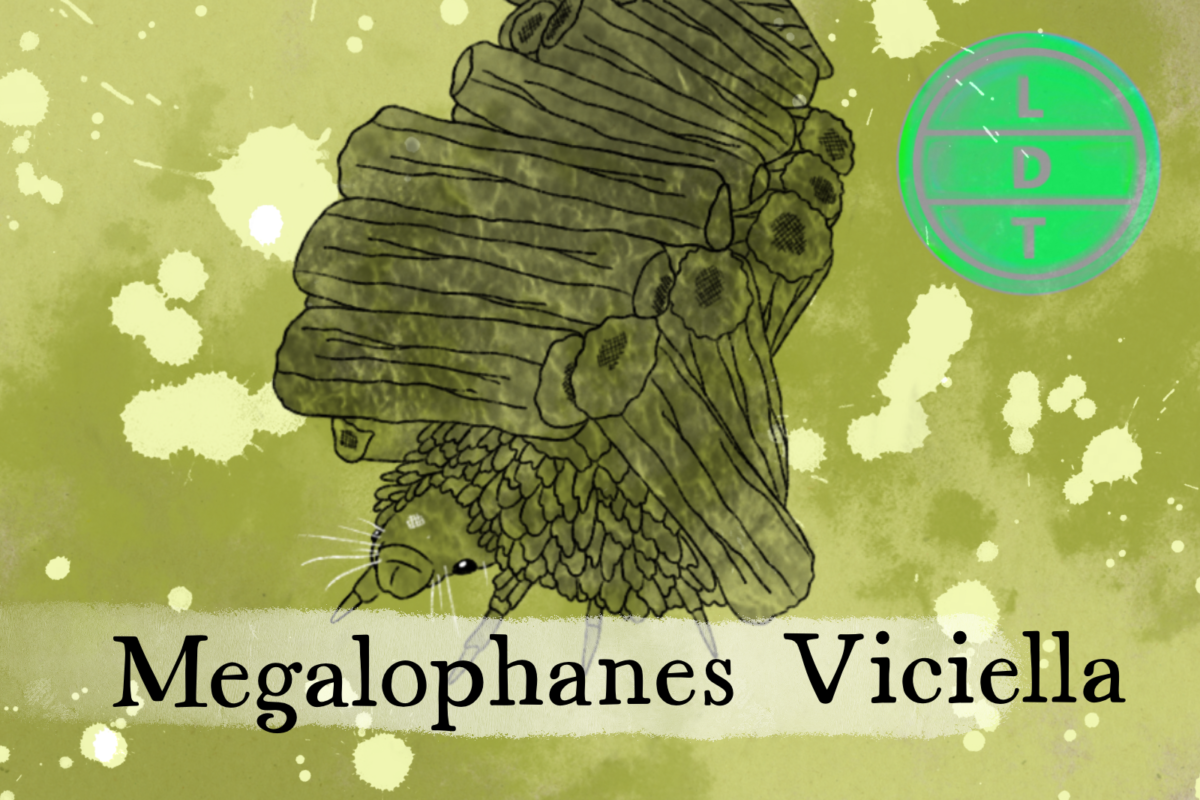“…and today we’re talking about a tiny Lincoln in a Tiny cabin. But more on that later.”
Humans have long desired to sit by a warm hearth, with a roof over their head, protected from the elements. Shelter is not a yearn unique to humans. All kinds of animals burrow and build to keep the predators and weather at bay. The bagworm moth caterpillar is one such industrious builder, but they’re also rambling characters, looking to the horizon. A mobile home seems like the perfect way to crawl through Life, Death, and Taxonomy.
Description of the Bagworm Moth Caterpillar
- Extremely fuzzy muffin
- Yellow-brown puff ball with four transparent wings like a dragonfly
- Kinda looks like a bee that got a pokemon evolution
- The lower half of its body (the abdomen) is a longer, segmented tail
- Has two long feathery antennae coming from its head
Measure Up
Welcome to the beloved Measure Up segment. The official listener’s favorite part of the show! The part of the show when we present the animal’s size and dimension in relatable terms through a quiz that’s fun for the whole family. It’s also the part of the show that’s introduced by you when you send in audio of yourself saying, singing, or chittering the words Measure Up into ldtaxonomy at gmail dot com. We don’t have a new Measure Up intro!
Worm from Labyrinth
Moth Wingspan
- 18–22 mm
- How many Bagworm moths go into the distance Kelvin Kiptum could run in two hours?
- Hint: Kiptum is a distance runner from Kenya, who sadly died in a car accident this past Sunday, February 11, 2024 at the age of 24. He was a livestock herder as a boy and trained to become an electrician until his running career took off. He is a world record holder and nearly broke a record time thought to be impossible.
- 1,917,954.55 bagworms. He nearly ran the marathon in under two hours. 42.195 km (26 mi 385 yd)
Bag Length
- 17 to 22 millimeters
- How many bagworms go into the length of the Old Faithful Inn from the east to west wing?
- Hint: The Old Faithful Inn is considered to be the largest log structure in the world. There is some contention that the Old Forestry Building, built in Oregon during Lewis and Clark’s expedition, was larger before burning down in 1964. However, even at the time before its additions, the Old Faithful Inn building was larger.
- 9,545.4 bagworms. The inn is 700 feet (210 m) long.
Fast Facts about the Bagworm Moth Caterpillar
- Range: It is found in most of Europe, except most of northern Europe, the Mediterranean and Great Britain. It is also found across the Palearctic to Japan.
- Diet: Caterpillars feed on various plants including grasses, sedges, flowering plants, heathers, birch trees, clown’s woundwort (purple flower), berry bush leaves.,
- Behavior:
- 1350 species of bagmoth
- One species of bagmoth is collected as food
- They don’t live long, just long enough to breed and lay eggs. Some bagmoths parthenogenetic – meaning females can lay fertile eggs without male fertilization
- Birds will sometimes eat the egg-laden female and the hard-shelled eggs pass straight through the bird’s digestive system to be spread out over a wider range (like a plant would distribute seeds)
Major Fact: Cabin in the Woods
Have you ever been in the woods and seen a mysterious cabin? What if that cabin was tiny and moving along a branch?
Bagworm larvae create protective cases made of sticks to camouflage themselves and protect against predators. The construction of these cases serves as a form of defense and shelter. The larvae incorporate materials from their environment, such as twigs, leaves, and debris, into their silk cases.
The case not only provides physical protection but also blends with the surroundings, making it harder for predators to detect and reach the larva inside.
Different bagworms create extremely different kinds of bags, to the point that the species are primarily identified by the materials they use to make the case.
Twigs are common, but they may be placed vertically or horizontally relative to the bagworm’s body. Some are joined together neatly and uniformly, while others are haphazard. Some species forgo plant material and use things like down feathers for a more luxurious mobile home. I saw one that looked like a tiny black witch hat.
Megalophanes viciella makes a bag that looks just like a tiny Lincoln log cabin. Tiny sticks are stacked in a square or criss cross pattern.
Whatever the material used, the caterpillars use silk to glue the structure together. When they decide to park for a while, they will also glue the case to whatever they are on to give their home some more stability.
When they decide to pupate, they have a readymade protective casing for their pupa, which is stuck to a branch or leaf.
Ending: Find a choice tree, try to reproduce before you die, and build an off-grid cabin in the woods when you’re ready to pupate like the bagmoth here in LDT.

